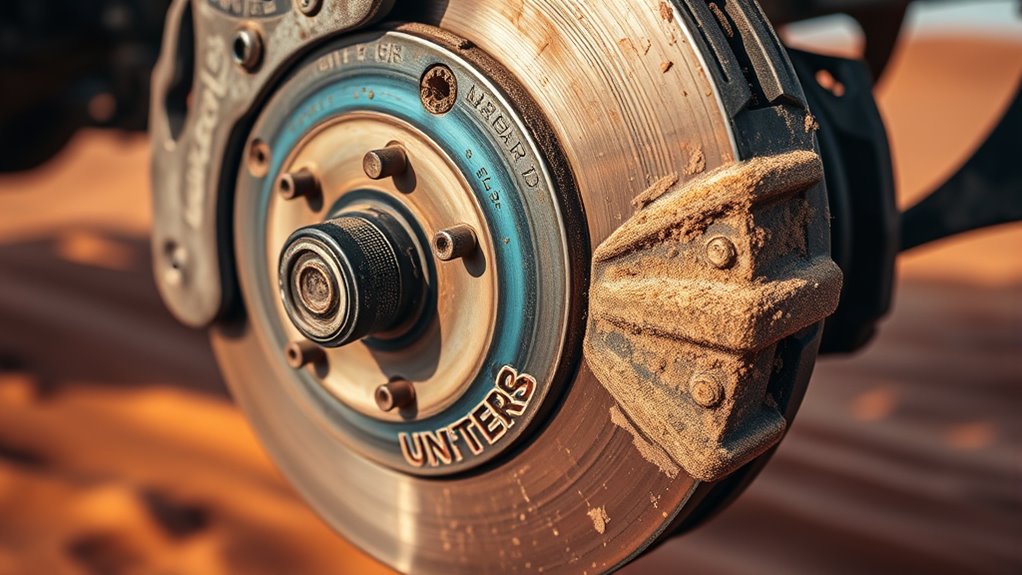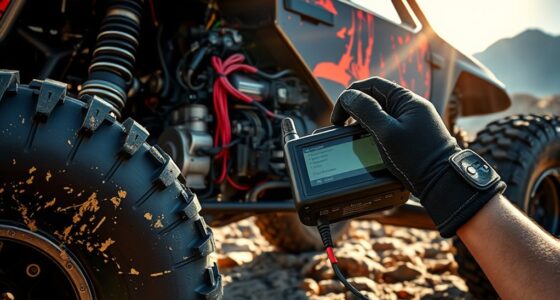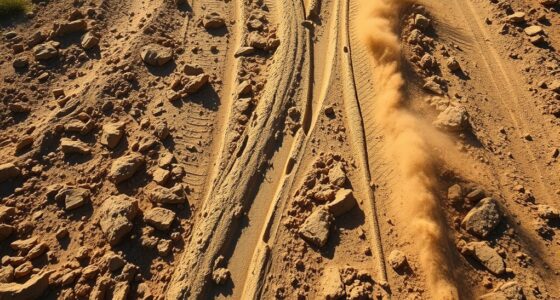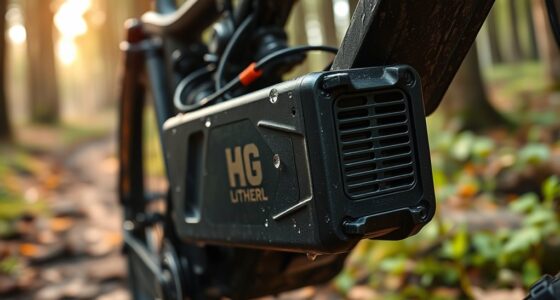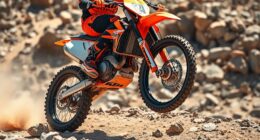In endurance desert racing, brake fade happens when excessive heat from prolonged or aggressive braking reduces your stopping power. To prevent this, choose high-quality brake components like ventilated rotors and high-temp pads, and guarantee proper cooling with ducts and heat sinks. Regular maintenance and monitoring brake temperatures help avoid fade during a race. Knowing the causes and prevention techniques can keep your vehicle safer and your performance consistent; learn more to master brake management in tough conditions.
Key Takeaways
- Excessive heat from prolonged braking causes brake fluid boiling and component overheating, leading to fade.
- Worn brake pads and inadequate cooling increase thermal buildup, reducing braking efficiency during endurance events.
- Proper heat dissipation techniques like ventilated discs and cooling ducts are vital to prevent brake fade.
- Using high-performance materials such as carbon-ceramic rotors and heat-resistant brake fluids enhances heat management.
- Regular maintenance, including inspection and monitoring temperature sensors, helps prevent brake fade and ensures reliable braking performance.
Understanding Brake Fade and Its Impact on Desert Racing
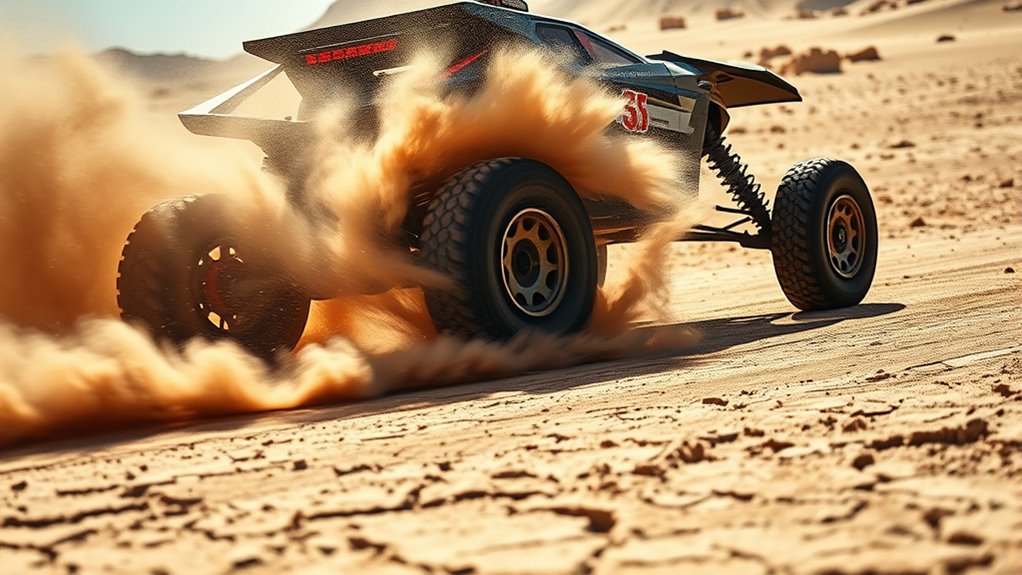
Brake fade is a critical issue in desert racing, where high speeds and rugged terrain push braking systems to their limits. When you brake hard and often during long stretches, the friction generates heat that can reduce braking efficiency. As temperatures rise, brake components become less effective, making it harder to slow down or stop quickly. This loss of braking power can lead to dangerous situations, especially on steep descents or tight turns. You might notice your brakes feeling softer or less responsive over time, which signals fade. Understanding how brake fade impacts your ability to control the vehicle is essential for safety and race performance. Properly managing your braking technique and equipment can help mitigate fade, keeping you safer on the demanding desert terrain. Regular maintenance and upgrading to high-performance brake components, such as performance brake pads, can also help prevent fade during extended races.
The Physics Behind Brake Fade: Heat Generation and Dissipation

When you brake, friction converts kinetic energy into heat, causing heat to build up rapidly in the brake components. Effective cooling strategies help dissipate this heat, preventing the temperature from reaching levels that cause fade. Understanding how heat accumulates and how cooling methods work is key to maintaining brake performance under stress. Incorporating proper maintenance routines ensures that cooling systems operate efficiently and can significantly reduce the risk of brake fade during intense braking conditions.
Heat Accumulation Mechanics
As you apply pressure to the brake pedal, friction between the brake pads and rotors converts kinetic energy into heat, causing temperatures to rise rapidly. This heat doesn’t distribute evenly; instead, it accumulates in specific areas, especially where friction is most intense. Continuous braking during endurance racing leads to a buildup of thermal energy, which can cause the brake components to reach critical temperatures. The rate of heat accumulation depends on factors like braking force, vehicle weight, and brake material properties. If heat isn’t dissipated quickly enough, it creates a cycle of rising temperatures that can weaken brake performance. Understanding how heat accumulates helps you recognize the importance of managing thermal buildup to prevent brake fade and maintain consistent stopping power. Sound healing science research indicates that effective heat dissipation can be supported by specific frequencies and vibration techniques to optimize thermal regulation in materials.
Cooling Strategies Effectiveness
Effective cooling strategies are vital to prevent heat from building up to damaging levels. Proper dissipation maintains brake performance and prevents fade. To maximize effectiveness, consider these key methods:
- Ventilated Brake Discs: They increase airflow, helping heat escape faster.
- High-Performance Brake Fluids: They resist boiling, maintaining consistent pressure.
- Adequate Ventilation System: Ensures continuous airflow around brakes during race conditions.
- Active Cooling Devices: Such as cooling ducts or fans that direct cool air onto brake components.
These strategies work together to improve heat dissipation, reducing the risk of brake fade. Understanding the physics of heat transfer—conduction, convection, and radiation—helps you optimize cooling, guaranteeing your brakes stay reliable, even under extreme conditions. Incorporating advanced cooling techniques can further enhance heat management during intense racing scenarios. Proper cooling is vital for endurance desert racing success.
Common Causes of Brake Fade in Endurance Events

One of the primary causes of brake fade during endurance events is excessive heat buildup in the brake components. When you brake repeatedly or hold the pedal down for extended periods, friction generates significant heat. If your cooling system isn’t sufficient, this heat accumulates quickly, causing brake fluid to overheat and vaporize, reducing braking efficiency. Worn brake pads or rotors also contribute, as they generate more heat under stress. Additionally, poor ventilation or inadequate cooling ducts trap heat, worsening the problem. If you don’t address these issues, the heat can lead to brake fluid boiling, pad glazing, and rotor warping—all of which impair braking performance. Recognizing these causes helps you prevent brake fade and maintain control during demanding endurance races. Proper thermal management strategies are essential for minimizing heat buildup and ensuring consistent braking performance throughout the event.
Signs and Symptoms of Brake Fade During a Race

As brake fade begins to set in during a race, you’ll notice your braking power diminishes noticeably. You might also feel an unusual softness or sponginess in the brake pedal, making it harder to judge stopping distances. Recognizing these signs early helps you respond quickly and prevent potential safety issues. Additionally, brake system overheating can contribute to fade, so monitoring temperature levels is crucial.
Reduced Braking Power
During a race, reduced braking power becomes noticeable when your brake pedal requires more effort to slow down the vehicle or when the car takes longer to respond to brake inputs. You might experience:
- A spongy or soft pedal feel that doesn’t firm up under pressure
- Longer stopping distances, even with firm pedal application
- Inconsistent braking response, where some stops feel weaker than others
- The need to press the brake pedal closer to the floor before feeling any effect
These signs indicate your brakes are losing effectiveness, often due to heat buildup or brake system issues. Recognizing these symptoms early helps you avoid brake failure and manage your race strategy effectively. Additionally, brake system maintenance plays a crucial role in preventing fade and ensuring consistent performance throughout the race.
Unusual Brake Feel
Unusual brake feel often signals that brake fade is occurring on the race track. You might notice a spongy, soft, or inconsistent pedal, making it hard to gauge braking force. The pedal may sink further than normal or require more pressure to slow down. Sometimes, you’ll feel vibrations or pulsing through the pedal, indicating uneven brake pad contact or overheating. These sensations can catch you off guard, especially during critical braking zones. Recognizing these signs early helps you avoid losing control or overshooting corners. Pay close attention to how your brake pedal responds; any deviation from your standard feel could be a warning. Staying alert to these subtle changes allows you to adapt your braking technique and prevent further brake fade or failure during the race. Monitoring brake temperature and ensuring proper cooling can also help mitigate the risk of fade.
Materials and Components That Influence Brake Performance
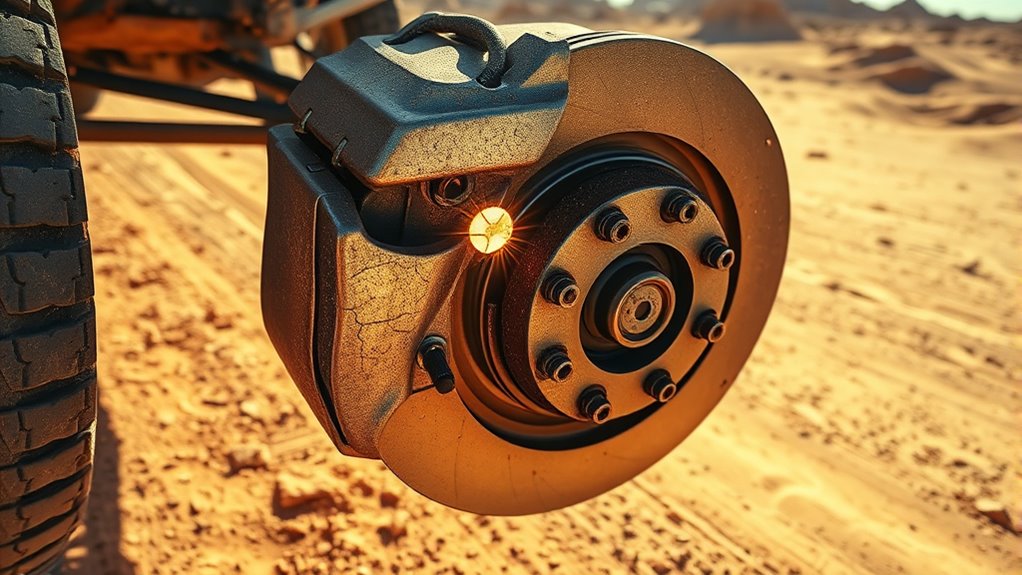
The materials and components used in brake systems directly impact their ability to perform under high-stress conditions. Your choice of brake pads, rotors, calipers, and fluids determines how well your brakes handle heat and pressure during endurance desert races. For example:
Choosing the right brake components ensures reliable performance in high-stress desert racing conditions.
- Brake Pad Material: Organic, semi-metallic, or ceramic pads each offer different heat tolerance and wear rates.
- Rotor Composition: Cast iron rotors provide durability, while carbon-ceramic rotors excel at heat dissipation.
- Caliper Design: Multi-piston calipers improve clamping force and brake modulation.
- Brake Fluid: High-temperature brake fluids prevent boiling and maintain consistent performance under extreme heat.
- Application Timing: Proper application timing ensures optimal performance and reduces the risk of fade during long races.
Selecting the right combination guarantees your braking system remains dependable and reduces the risk of fade during long, demanding races.
Strategies to Prevent Brake Fade Before and During Races

Preventing brake fade starts well before you hit the race track by implementing proper preparation and maintenance strategies. Inspect your brake system thoroughly, ensuring all components are in good condition and free of wear or damage. Use high-quality brake fluids with appropriate boiling points to handle extreme heat, and regularly bleed the brakes to remove air bubbles that can impair performance. Adjust your brake bias for maximum cooling and avoid overusing brakes on long descents by planning your braking points carefully. During the race, modulate your braking to prevent overheating, avoid aggressive pedal application, and look for signs of brake temperature buildup. Staying alert and managing your braking technique helps maintain consistent performance and reduces the risk of brake fade during critical moments. Incorporating appropriate brake fluid types can further enhance heat management and prevent fade during intense conditions.
Maintenance Practices to Minimize Brake Fade Risks
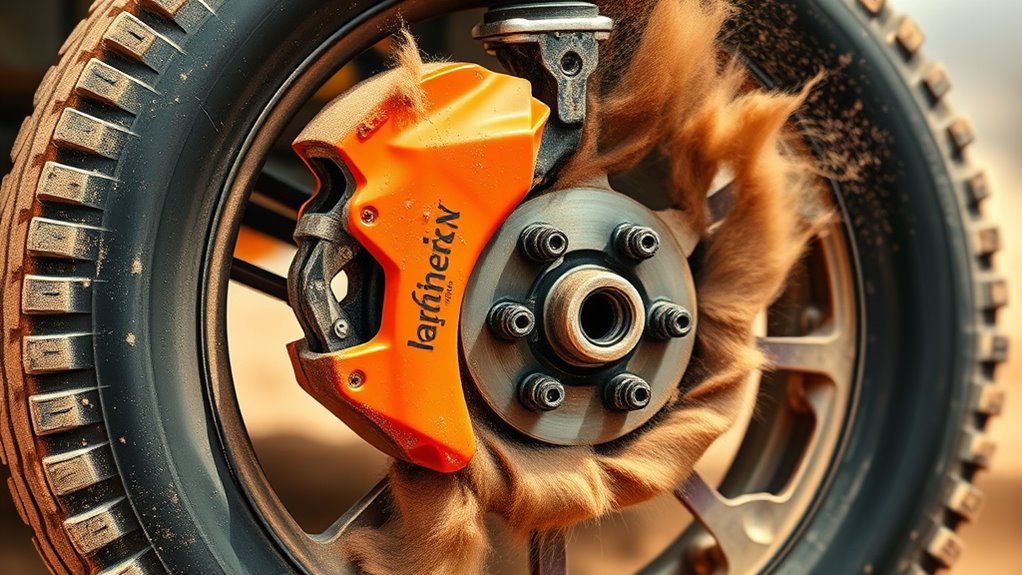
Regularly inspecting your brake components is essential for minimizing brake fade risks. By keeping your brakes in top shape, you prevent issues that could lead to overheating and reduced performance. Focus on these key maintenance tasks:
- Check brake pads for uneven wear and replace them as needed.
- Inspect rotors for warping, cracks, or grooves, and machine or replace if necessary.
- Ensure brake fluid is clean, at the correct level, and replaced periodically.
- Tighten brake calipers and fittings to prevent leaks and maintain proper pressure.
Performing these routine checks helps maintain ideal brake system efficiency. Staying proactive reduces the chances of brake fade during demanding desert races, ensuring your brakes remain reliable when you need them most.
Advanced Technologies and Innovations for Brake Management
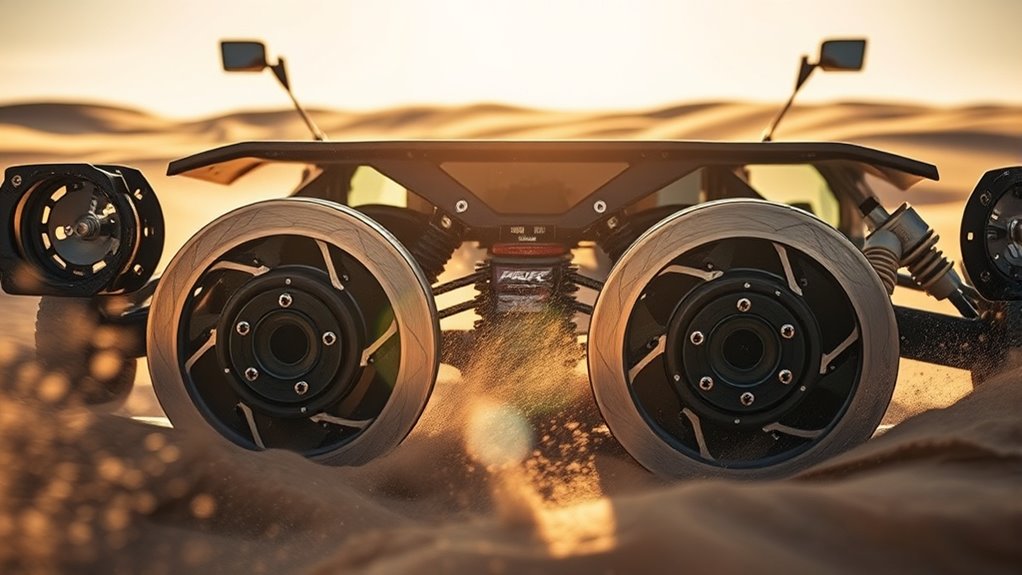
Advancements in brake technology have revolutionized how vehicles manage heat and maintain performance under demanding conditions. Modern brake systems incorporate materials like carbon-ceramic composites that withstand higher temperatures without fading. Active cooling systems, such as ducted vents and heat sinks, direct airflow to critical components, preventing overheating during prolonged braking. Electronic brake force distribution and anti-lock braking systems (ABS) optimize brake application, reducing uneven wear and heat buildup. Regenerative braking recovers energy, lessening the load on traditional brakes and keeping temperatures lower. Sensors monitor brake temperature in real-time, alerting drivers or automatically adjusting brake pressure to prevent fade. These innovations help you maintain consistent braking power, improve safety, and extend component lifespan, especially in endurance desert racing where heat management is crucial.
Frequently Asked Questions
How Does Driver Technique Influence Brake Fade in Desert Racing?
Your driving technique plays a key role in brake fade during desert racing. When you brake too hard or too long, heat builds up quickly, causing brake fluid to boil and pads to overheat. By modulating your braking, using engine braking when possible, and avoiding sudden stops, you reduce heat stress on your brakes. Smooth, controlled braking helps maintain brake performance, preventing fade and ensuring you stay in control through challenging terrain.
Are There Specific Brake Cooling Methods Tailored for Desert Conditions?
Did you know proper brake cooling can reduce fade by up to 50%? In desert conditions, you should implement tailored methods like adding high-performance brake ducts, using heat-resistant pads, and regularly flushing cooling systems. These strategies help dissipate heat more effectively, preventing brake overheating during long runs. By focusing on specialized cooling setups, you guarantee your brakes stay responsive, giving you a vital edge in desert endurance races.
What Role Does Tire Choice Play in Brake Performance and Fade Prevention?
Tire choice *substantially* impacts brake performance and fade prevention. You should select tires with good grip and heat resistance, as they help maintain better traction and reduce excessive brake force. Opt for tires that dissipate heat efficiently, preventing them from overheating under stress. Proper tire selection ensures smoother braking, minimizes heat buildup, and prolongs brake life, ultimately helping you avoid brake fade during demanding desert endurance races.
Can Vehicle Weight Distribution Impact Brake Fade Severity?
Think of your vehicle like a balanced scale—when weight is unevenly distributed, it puts extra pressure on certain brakes. You’ll notice that uneven weight shifts brake heat and wear, making fade worse. By maintaining proper weight balance, you help your brakes work more evenly, reducing the risk of fade. This keeps your stopping power reliable, especially in the grueling conditions of endurance desert racing.
How Do Different Desert Terrain Types Affect Brake Cooling Strategies?
Different desert terrains considerably influence your brake cooling strategies. For soft sand, you should reduce braking early to prevent overheating, while rocky terrain requires careful, controlled braking to avoid brake fade. Gravel and loose surfaces demand frequent brake checks and cooling pauses. Adjust your approach based on terrain, using airflow and brake ventilation enhancements where needed. Staying attentive to terrain variations helps you maintain ideal brake performance and prevent fade during your race.
Conclusion
By understanding and tackling brake fade, you’re steering your vehicle through the fiery furnace of heat and pressure, like a skilled firefighter controlling a blaze. With the right materials, vigilant maintenance, and smart strategies, you’ll keep your brakes cool and confident, turning the treacherous desert into your playground rather than a trap. Remember, staying ahead of brake fade is like having a shield of ice in a scorching sun—crucial for victory and safety.
